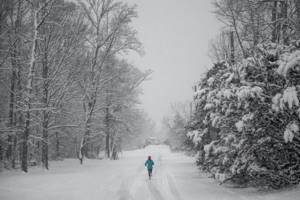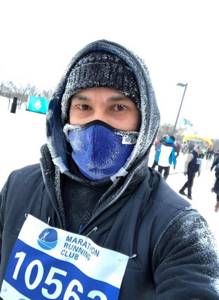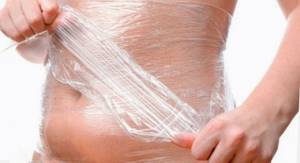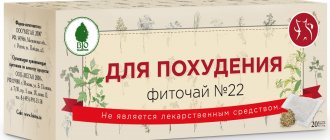The benefits of winter jogging
The benefits of running are undeniable, and in winter there are several more advantages:
- Physical activity in the fresh air has benefits for the respiratory system. And due to the fact that winter air is richer in oxygen than summer air, it is much easier to breathe while jogging.
- In winter, the ankle joints, as well as the muscles of the thighs and buttocks, are strengthened much more effectively. The body spends more energy moving on slippery roads or snow drifts. In addition, the immune system is strengthened, mood improves, endurance and willpower are developed.
- In such conditions, the heart and lungs develop well. The body will gradually begin to harden and in the future low temperatures will not make it shiver from the cold.
- Jogging provides a large supply of oxygen, and even more so in winter, so winter jogging helps you lose weight faster.
About the benefits
Any outdoor training during the winter season combines work on sports performance and hardening. If you take all precautions and dress appropriately for the weather, your immunity will become stronger over time. Seasoned people get sick less often, and if they do encounter a cold or viral disease, they experience it in a mild form.
It is known that running is the best exercise for losing weight; in winter its effectiveness increases many times over. At any time of the year, aerobic exercise burns a lot of calories; at cool ambient temperatures, energy consumption increases, since it is spent not only on physical activity, but also on heating the body. The more calories you burn, the faster your fat deposits are burned.
It is impossible not to note the benefits for the respiratory system and improvement in blood composition. The oxygen concentration in cold air is one third higher than in warm air. Because of this, the lungs can absorb more oxygen, and the blood is saturated with this vital element faster.
Winter jogging involves the need to overcome slippery areas, go around and jump over snowdrifts. Thanks to this, the muscles and joint apparatus receive more functional load and quickly get into good physical shape. In addition, such obstacles develop willpower and build character. After each workout, you feel a surge of energy and vigor; it’s not only about activity, but also about the psychological aspect. The ability to run even in the cold season is a reason to be proud of yourself.
Running in winter: how to start as a beginner, and is it worth it?
Even if you haven’t run before, but now you have a desire to try yourself in winter jogging and it’s not clear where to start, these tips will help you:
- It is, of course, better to start preparing for winter jogging before the onset of cold weather. If you start running at least in September, it will be easier for your body to get used to running in winter.
- First of all, make sure that running in the cold will not harm you. Go for a run only if you are healthy and do not have a cold. Even a runny nose and cough is a reason to stay home.
- The running time in winter directly depends on the weather. The lower the temperature and the stronger the wind, the shorter your workout should be. Don't risk getting frostbite. Even athletes try not to run in temperatures below 15 degrees.
- While running, you should not openly sweat or, on the contrary, freeze. Do a warm-up before going out - this is useful and during this time you will understand whether you are comfortable in the equipment.
- Be sure to keep your back and stomach warm. Pull leggings or tights so that the lower back is covered.
- While running, it will be tempting to breathe through your mouth, but try to train yourself to breathe through your nose so as not to get a cold in your throat. When you breathe through your nose, the cold air has time to warm up and this is less dangerous.
- Don't run too fast to avoid shortness of breath and suffocation in cold air.
- The best way to warm up after a workout is a warm shower and warm tea or lemon water. It will also help avoid pain in clogged muscles.
Find like-minded people, in the first days you will spur each other on and not let you get stuck
Try to start running following these rules and focus on your feelings
How to dress so as not to freeze

Dressing for running in winter should not be too warm, but not too light either.
Here, in fact, it is important to maintain a “golden mean” so as not to dress too warmly: you will sweat a lot, become icy and catch a cold. Conversely, it is too easy not to freeze from the very beginning.
Follow the layering principle
- The first layer should be able to remove moisture. That is, cotton T-shirts and long sleeves are not suitable, after 10 minutes they will become wet and any breath of wind will pierce you with cold. Now there is quite a wide selection of synthetic thermal underwear - pay attention to it.
- The second layer (at temperatures below -5 C) is warming, but it should also be able to remove moisture; fleece jackets are suitable.
- The third layer is wind/moisture-proof with a membrane or other technologies that allow protection from precipitation and wind.
The third layer can also be additionally insulated with fleece or “down” inserts, which allows you to manipulate the layers depending on the air temperature. For example, at temperatures: – up to -5 degrees, the first and third layers are sufficient; – from -5...-10 degrees – the first plus an insulated third layer (insulated); – below -10 all 3 layers are needed.
Legs are a working organ and generate a lot of heat, so it is enough to insulate them with a maximum of 2 layers: thermal and windproof. In winter, you should also replace socks with insulated ones, or wear 2 pairs - according to the principle of layering.
Protect high heat transfer areas
These are the head, neck, hands, chest and lower back. If these areas get too cold, comfort and temperature perception throughout the body will be affected (meaning you can still get cold!).
Therefore, gloves, a hat, buffs/scarves are mandatory accessories for winter training. It would also be a good idea to pay attention to down vests, which protect the chest and waist well and at the same time lighten the overall weight of the equipment.
Go for a run warmed up
Before training, take 10 minutes to pre-warm up. Perform joint exercises and a few exercises that will warm up your muscles, but will not allow you to sweat too much. This could be squats, calf raises, exercises with harnesses, or various balance complexes. If, despite all the techniques during winter training, your knees or ankles are cold and sore, then you can try rubbing them with a warming ointment (Nicoflex, Capsicum) 30-45 minutes before training. This will also improve the perception of low temperatures and increase the effectiveness of the workout, since a good warm-up always has a positive effect on intensity.
Don't stay out in the cold after training
As long as you are on the move and dressed adequately, it is quite difficult to freeze. But as the intensity decreases, the muscles generate less heat and the outside temperature will gradually begin to dominate, especially if there is wind. Therefore, if you run from home, then try to finish your running route closest to the entrance. And if you are training on the road, try to change into dry clothes as quickly as possible.
What are the dangers of running in winter?
Obviously, a low temperature and a greater likelihood of getting sick. But there are a few more reasons you should consider when weighing the pros and cons of winter running:
The danger and risk is that the likelihood of injury increases on snow and slippery trodden paths. Therefore, it is important to understand that winter sneakers and equipment must be selected specifically for weather conditions.
If the temperature is below 10°C, the risk of respiratory hypothermia increases, which can lead to serious illness. These troubles can be avoided by learning proper breathing and using a mouth mask.
There is a danger even if you run in the summer, the main thing is to follow the instructions and neglect safety measures. If you have never exercised before, much less run outside, don’t rush into winter jogging. It’s better to go to a sports club before it warms up.
Warm-up
Many novice athletes neglect the preparatory stage, which is a serious mistake. A good warm-up prepares the body for the upcoming loads. If you run outside in winter to lose weight, it “programs” it for an active process of burning calories.
In the warm season, not much time is devoted to warm-up, but in winter it should take at least 2 times longer. This is necessary for uniform warming of all muscle groups. There is no special set of exercises before winter jogging; they are standard and must include stretching. It is important for preparing ligaments and muscles for serious loads.
A good warm-up with an emphasis on stretching significantly reduces the risk of various injuries.
Is it possible to lose weight by running in winter?
Running itself is one of the best ways to lose weight, and in winter the effect is enhanced due to:
- Increasing the load on the muscles due, oddly enough, to a more slippery running path. For better grip, the ankle, muscles of the buttocks, thighs and calves are tensed.
- If you are running on an off-the-beaten path covered in snow, this also increases the load due to resistance and raising your legs higher.
Running in winter and a healthy, balanced diet help you lose weight. An integrated approach allows you to effectively get rid of excess weight.
Rules for running in winter
In winter, it is especially necessary to follow all the rules so that running will benefit you and strengthen your body, and not frostbite and worsen your condition.
Warm up before your run
There must be a warm-up, and it is necessary to work out all muscle groups. It is better to do this in a warm place, before going outside. It is enough to do a simple stretch, warm up the muscles, but not allow perspiration to appear, but if you ignore the warm-up, you can get injured.
Winter jogging should start from the threshold of the house to the place of jogging and back to the house without stopping. This is not difficult to do if you do not walk along the road from the house and to it, but run at a light jog.
All eyes on running
When training in winter, you need to focus on the process itself, because the surface on which you run can be slippery and there is a high probability of falling and getting injured. If you slip, you need to have time to group yourself correctly. The most dangerous sections of the route are the ascents, descents and turns. You need to be extremely careful with them.
Choose the right clothes
Running in winter is good for your health only with the right equipment. Mistakes that new runners make include wearing too much clothing, overheating, and eventually catching a cold. You need to dress as if the temperature outside is 10-15°C higher. A training suit should protect against the cold, but at the same time be light and comfortable so as not to restrict movement.
It is necessary to protect all parts of the body from blowing:
- Head. It is recommended to use masks and hats. You can buy special glasses that will improve visibility even during a snowstorm. The hat should cover your ears - you can wear a warm cap, a fleece hat or fur headphones. A scarf or special collar will protect your mouth and neck.
- Hands. Wool mittens retain heat better than gloves. If possible, you can purchase sports gloves. They will protect your hands from the cold and from impact if you slip and fall.
- Legs. Socks are an important part of your uniform. It is not recommended to wear cotton and wool, and preference should be given to products made of synthetics or fine wool with a thermal effect. In warm weather, one pair of sweatpants is enough. In cold weather, it is recommended to wear thermal leggings underneath.

Thermal underwear, sweatpants, fleece, warm socks, special winter sneakers, hat, mask - complete equipment for a runner in winter
Choose the right shoes
- The right running shoes will help protect your knees and joints from injury. Forget about summer lightweight sneakers, your feet will freeze instantly in them.
- Choose sneakers made from a material that is breathable and protects against the cold. Sneakers should not allow moisture to pass through, otherwise they will not protect your feet from hypothermia.
- For running and maximum traction on slippery roads, you need a sole with deep grooves and made from different materials. The thickness of the sole is also an important factor: the protection of the foot from frost depends on it.
- For complete confidence in the clutch, professionals purchase special fasteners - chains.
- Pay attention to the lacing - it should not interfere with movement.
Winter running gear
What to run in in winter is the most important of all organizational issues. The equipment performs several functions at once: protects against hypothermia and illness, prevents injuries, helps withstand stress, and provides comfort. Clothing should consist of three layers:
- thermal underwear, worn on a naked body to maintain a stable temperature;
- the middle layer is insulated clothing. It should not be too warm, otherwise the runner will sweat too much;
- the top layer is pants and a jacket. They perform a protective function and must be waterproof and windproof.
In addition to clothing, you will need accessories: a scarf or collar, a hat and gloves, as well as suitable shoes. If you choose the right equipment, you will be comfortable working out in it both at zero temperatures and at minus 15.
Thermal underwear
It is important not only to choose the right thermal underwear, but also to use it correctly. Athletes prefer sets made of artificial materials that do not absorb sweat, but remove it from the body. The underwear must fit perfectly, otherwise the whole point of using it is lost. It will also become useless if you wear it not on your naked body, but on other wearable items. Good kits are made using a seamless method; when running, the seams dig unpleasantly into the skin or rub.
Middle layer
Very warm clothes are not suitable, so you can immediately forget about wool sweaters and other wool products. Fleece jackets and sweaters are great; it is a soft and pleasant material that does not absorb sweat. The jacket should not fit tightly, since the air layer between the bottom and middle layers retains heat, and not the clothing itself.
Protective layer
This layer is the lightest, since its purpose is not to maintain temperature, but to protect against rain, snow and wind. Runners choose bright jackets and pants for a reason. Even those who regularly exercise are susceptible to seasonal blues. Favorite colors in clothes keep you motivated and improve your mood.
Shoes
The main piece of running equipment is sneakers. You cannot use demi-season shoes in winter for a number of reasons:
- the thin sole will allow the cold from the frozen ground to pass through;
- the winter soles have an anti-slip texture; without it, running on snow and ice is dangerous;
- Demi-season shoes do not have fur insulation or moisture-resistant coating;
- Sneakers for cold weather have tighter lacing, this is a measure to retain heat and protect against snow.
You shouldn’t skimp on winter sneakers; they should be of high quality. A good pair will not start to crack due to temperature changes. It should have good shock absorption to help maintain balance on slippery surfaces or snow. You should not choose your size, but leave a margin of at least one and a half sizes. This will allow you to put on warm socks and leave a small layer of air to retain heat.
Accessories
The density of the hat depends on the temperature, but in any case it should protect your ears from the cold. A balaclava is perfect for cold weather; it is a thick hat that covers the entire face except for the eye area. If it snows, your eyes will also need protection; special glasses are used for this. A scarf or snood is needed to keep the neck warm. You will also need gloves or mittens. Gloves are more functional, but they retain heat less well. In mittens, the fingers are in one section, this will make your hands warmer.
Maximum temperature
Beginning runners do not know what temperature they can run in in winter. This parameter depends on the level of training of the person. And since the duration of runs at the initial stage is minimal, only 10 or 15 minutes, during this time you can understand your personal feelings of a comfortable temperature for running. Gradually increase your jogging time, by about 5 minutes per week, but be sure to keep an eye on the temperature.
In severe frosts, when the temperature drops below −15°C, jogging is not recommended - there is a high probability of catching a cold in the lungs. Ice and a strong snowstorm are also a good reason for not canceling your workout that day.

If you are not a professional runner, we advise you not to go jogging in frosts below −15°C or in a strong snowstorm.
It is worth taking into account the wind speed. Strong gusts make breathing difficult, and without this it is impossible to move normally. It’s also not a good idea to exercise in a blizzard; when there’s snow all around, it’s difficult to assess the surrounding situation and fully complete the race.
Lengthen your day
Of course, there are just as many hours left in the day. And you need to sleep no less than your individual norm, which means that in order to get up earlier, you will have to go to bed earlier. But in some mysterious way, when you get up early, the day becomes longer and you get more done. Most likely, it’s a matter of perception: when by 10-11 in the morning I’ve already run and managed to redo a lot of work, and there’s still a whole day ahead, then this is motivating. Plus, less time is spent on rocking and slowly waking up.
The feeling of having already completed a useful and pleasant task invigorates and sets the right mood for the whole day. In addition, in the early morning it is easier to find personal time, especially for family people, and there is less chance that a run will not take place due to sudden business, meetings or simply overwhelming fatigue.
I will write separately about how to transform from an owl into a lark. As a former night owl of 15 years, I have a lot to say on this topic.
Breath
- Inhale through the nose, exhale through the mouth. With this breathing technique you will not burn your lungs with frosty air. If you do the opposite, then sooner or later you can get a cold in your throat and bronchi. No matter how difficult it may be, breathing like this should become a habit for safe winter running.
- In cold weather, it is best to breathe through a scarf or balaclava.
- The risk of a cold throat increases if after a run you immediately switch to a calm walk. The body cools down quickly in such a situation. Therefore, it is necessary to continue all the way home so as not to lose your breath.
- The speed should be comfortable for the workout to be satisfying. Breathe calmly and deeply so that the body can get enough oxygen.
The best rule is to breathe naturally without focusing on it.
Good places to train
In winter, you should not use busy sidewalks for jogging, so as not to slip on the protopton paths. The best option is where the surface is cleared of snow and you can move easily, for example, a stadium with treadmills.
- Parks and embankments. Snow in these places is also removed, but not so thoroughly. The asphalt or sidewalk is still slippery in some places. The advantage of parks is that there is no air pollution.
- Outskirts of the city. Training in such places is characterized by increased strength load. The roads are not always clear, so you can practice running in deep snow. Such exercises help improve movement technique. This type of training is not suitable for the recovery and initial periods.
- Central streets. They are thoroughly cleared of snow, sprinkled with sand and salt, so it is convenient to move on them. But such substances quickly destroy the sole of sneakers. Another disadvantage is that in such places there is increased air pollution and it is difficult to breathe. For safety from the roadway, it is better to wear reflective clothing.
Think through your route before leaving home in advance so that you clearly understand how much time you will need and do not have time to freeze on the way home.
What to do after class
- After a run, you need to return to a warm room to warm up. Take off wet clothes and take a warm shower, dry yourself and change into warm clothes. If you feel chilly after the procedures, do some warm-up exercises or rub your body to get the blood flowing and warm up.
- Replenish the water-salt balance and drink 300-500 ml. warm water.
- You can eat after a run in 30-40 minutes. After training, it is not recommended to eat sweets, baked goods, salty foods, or coffee, because it leads to dehydration.
Tricks for winter jogging
- Before leaving the house, drink some warm water so that you don't feel thirsty while running.
- Under no circumstances should you stop, because this risks hypothermia. If your strength is running low, you need to slow down, but keep moving.
- Make sure you breathe correctly: inhale through your nose and exhale through your mouth. If your breathing is difficult and you can only breathe through your mouth, you should put your tongue on the roof of your mouth to block the flow of cold air.
- During severe frost, it is better not to train if you are not confident in your abilities. You should run along well-trodden paths so that fallen snow does not slow down your movement.
Winter running: obvious contraindications
You should start training only when you feel well. Even a slight runny nose is a contraindication, since cold air can aggravate the situation. If there are unhealed injuries to the lower extremities, physical activity is contraindicated.
List of diseases for which running is not recommended:
- thrombophlebitis;
- problems with the cardiovascular system;
- pathologies of the musculoskeletal system.
In each case, prior consultation with your doctor is required. Perhaps in some situations sports will be beneficial.
Don't strive for records when running in winter. In winter, under no circumstances set yourself the task of increasing any speed or endurance indicators. During this period, the main goal should be to improve the health of the body.
Running and losing weight: the most popular myths
There are a fairly large number of myths about running and weight loss that many people encounter sooner or later. They often become very unpleasant barriers to achieving an ideal figure or quickly losing excess weight. So, here are a few of the most popular myths about running that everyone should know about:
Myth 1. If you want to lose weight, run faster
Jogging is a thing of the past, as some may point out. In fact, if there is a need to get into good shape and maintain a healthy lifestyle, then jogging will help with this. If you run too fast, the body quickly depletes its energy reserves, and various health complications can also arise.
Myth 2. If you run regularly, you can eat anything

Of course, training will be a great excuse for those who want to enjoy buns and sweets. And it doesn’t even matter that a person ran for only 15 minutes, and after that he ate half a kilogram of sweets, because if you run, you don’t have to worry about what you eat.
Such thoughts are true only to some extent. It is important to consider how many calories were burned during the workout, and then decide how many are needed to replenish energy after the workout. You can easily gain weight if the calorie content of the foods consumed is greater than what a person spends while running.
Online food diary
Myth 3. To lose weight you need to run in the morning
In fact, everything depends only on the individual capabilities of a person and his chronotype. However, experts say that the most effective time for running is 10-12 am, since it is during this period that the cardiovascular system becomes more active.
Of course, you can go for a run at 5-6 in the morning or even at 8 in the evening, it all depends on the person’s individual schedule, as well as preferences. The number of calories burned will be almost the same regardless of the time of day.
Myth 4. Running with a wrap is the most effective way to lose weight quickly

Why not, because most athletes do this: they wrap themselves in film and quickly lose weight. What's really going on? Using wraps, you can artificially increase the temperature of tissues and increase the intensity of sweating. In this way, it will be possible to get rid of excess fluid in the body, but after a few days it will completely return. This method does not in any way affect the intensive burning of fat deposits.
Memo
- If you put aside your fears and follow the necessary rules, running in winter will strengthen your body and make it more resilient.
- Running in winter and a healthy, balanced diet help you lose weight. An integrated approach allows you to effectively get rid of excess weight.
- The duration of the run depends on the temperature outside; the colder it is, the shorter the run should be.
- If you have never exercised before, much less run outside, don’t rush into winter jogging. It’s better to go to a sports club before it warms up.
- In winter, do not set yourself the task of increasing your speed or endurance. During this period, the main goal is to harden and heal the body.
In the matter of strengthening the immune system, nutrition plays one of the main roles, as well as for the health of the body in general. We have prepared 3 services for you that will help you change and reconsider your views on nutrition and, as a result, strengthen your immune system and lose weight along with winter jogging. Enter your email and click the download button ↓ and receive a portion of useful tips.
Reviews from athletes and amateurs
The most noticeable effects of winter running, which amateurs note first of all, are improved mood and acceleration of the weight loss process. Many have noticed that fresh, cool air sharpens thinking; often while jogging or after it, solutions to important issues suddenly come to mind. Professionals treat this more cautiously, sport is their main activity, and it is extremely undesirable for athletes to get sick and be behind schedule. At the same time, doctors note that it is easier to get sick from the wind than from frost. You should not go outside if the gust speed exceeds 6-8 meters per second.
Amateurs cite the need to spend money on special shoes and clothing as the main disadvantage of running outdoors in winter. However, they also note that this is more profitable than going to the gym. Good equipment lasts at least 2-3 seasons; as a rule, its cost is not much more than paying for a gym membership.











